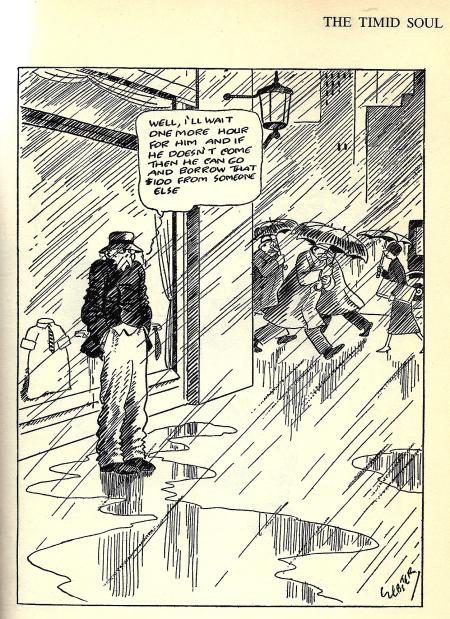As a blogger for American Humor Studies, I run an occasional series that explains the etymology of words that derive from humorous sources-particularly cartoons. It is fascinating how the words transition from neologisms that perform a particular task for the cartoonist, but are eventually adopted by the public, sometimes for a short period (as the following word was) and sometimes for hundreds of years (as "gerrymander" has been).
The last time I saw "milquetoast" or any form of the word was back in the 1970s. A coworker of mine mocked up a nameplate for one of our bosses that said "Casper Milktoast" and had put it on his desk. After asking him how he had come up with the name, he told me it was a term that his grandfather had used. It was later that I encountered it in a book of H. T. Webster cartoons.
"Milquetoast" is a derisive term for a timid, unassertive person. It comes from a Webster cartoon character named Caspar Milquetoast. Although the word is spelled "milque," it undoubtedly refers to "milk" and the effect that milk and other liquids have on bread when it is dipped in them. The bread, or toast, becomes soggy and malleable, and Webster named his soggy, malleable character for that phenomenon.

"The Timid Soul" pen and ink cartoon by Harold Tucker Webster in The Best of H. T. Webster by Robert E. Sherwood and Philo Calhoun. New York: Simon and Schuster 1953.
Why milk? Why not water? Milk is white, and men who have a white complexion are considered less rugged than those who have darker, tanned complexions. Combine that whiteness with sogginess and the term is less than flattering for a man. The interwar period was a time of racism in the United States with many symbols that represented perceived characteristics of blacks and whites. The symbol of paleness as representative of non-assertiveness supports the concept that blacks were rugged laborers and whites were among the leisure classes, but too much leisure and time out of the sun was perceived as unmanly. It is no surprise that cartoonists often exploit stereotypes to reinforce the hidden suggestions within the text and images.
Caspar Milquetoast first appeared in Webster's cartoons in 1924, but it was not until 1935 that it became a noun describing a timid soul. It may have derived from the term "milksop," which originated in the 14 th century and is also defined as a man who is unassertive. The name Casper was appropriated in 1939 by a new cartoon character called Casper (McFadden) the Friendly Ghost. With only the difference of the single vowel, both Casp(a)ers were blanched and timid. The word Casp(a)er derives from an Indo-European word for "treasurer" and is formerly related to gold. However, because of the friendly ghost and milquetoast, Casp(a)er is now associated with paleness and the eschewing of the rough and tumble world of the outdoors. As a possible result, neither form of the word "Casp(a)er" has been on the list of the top 1,000 baby names in many years.
